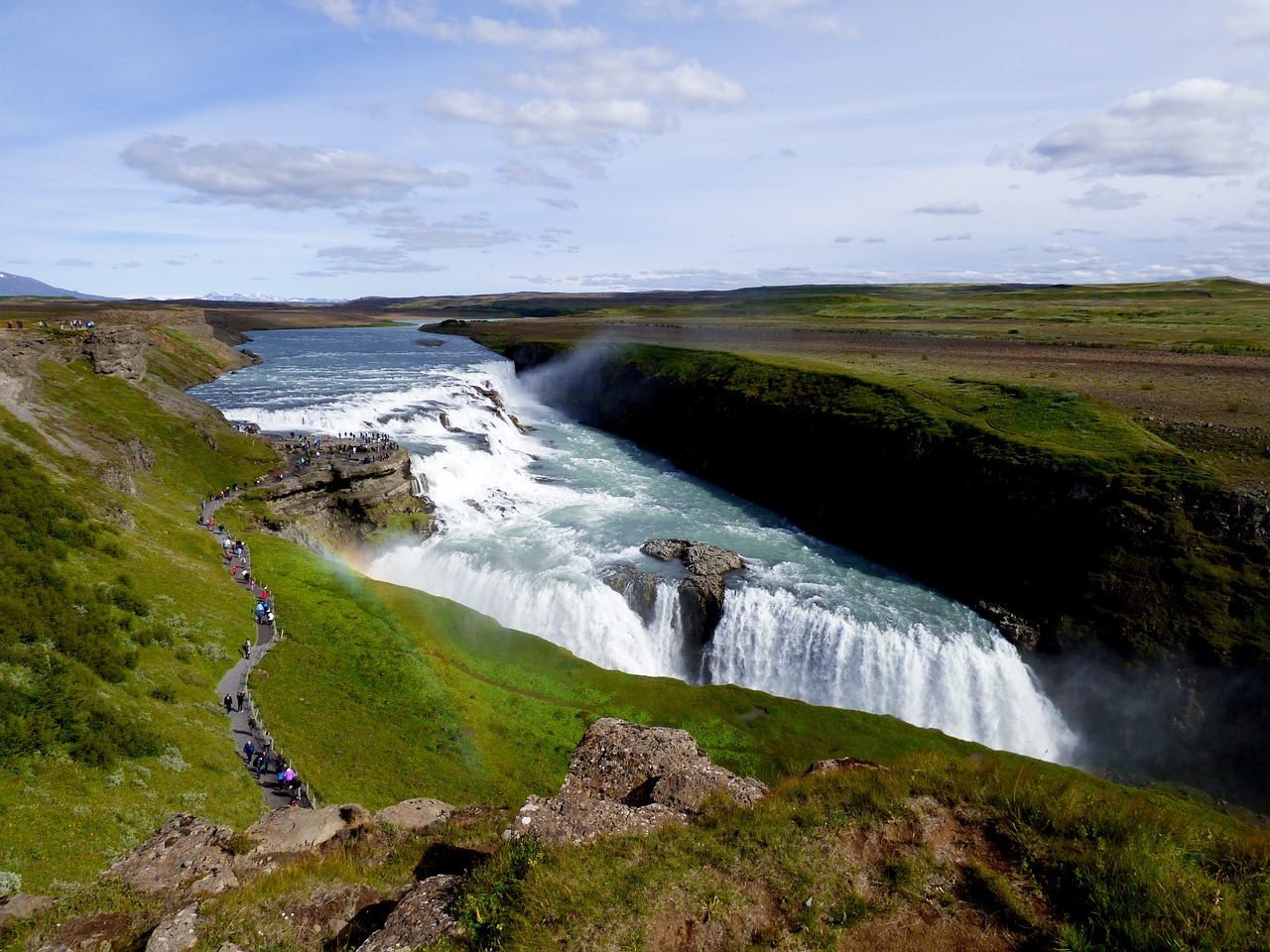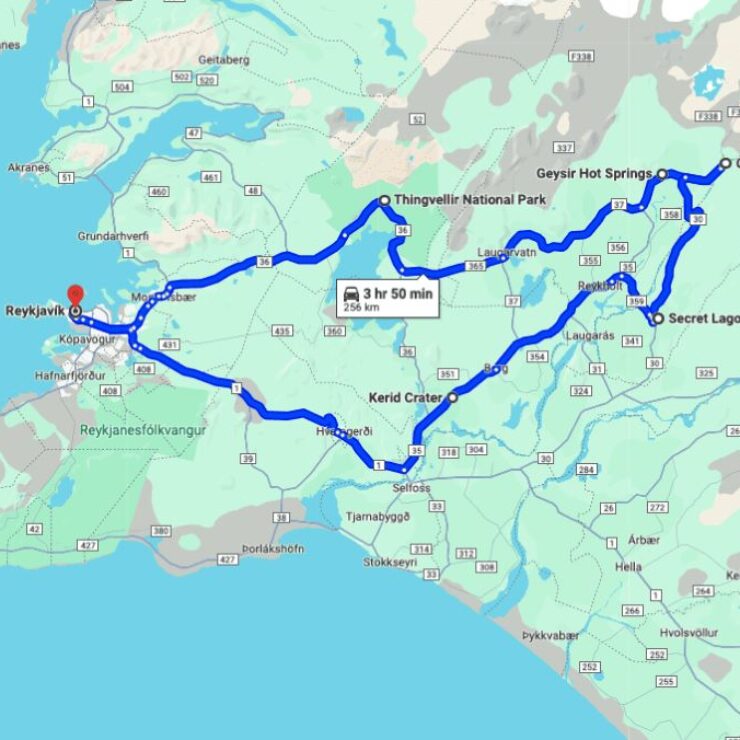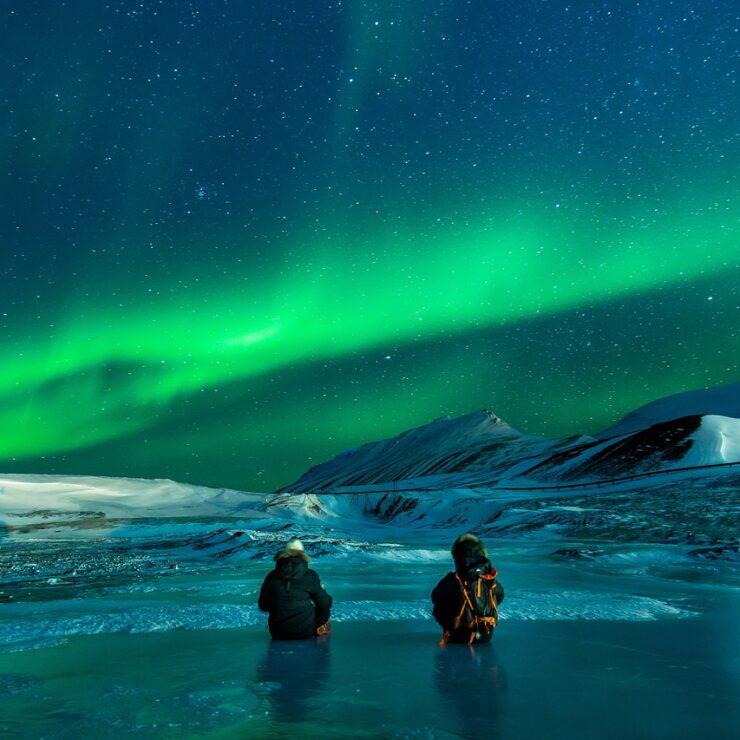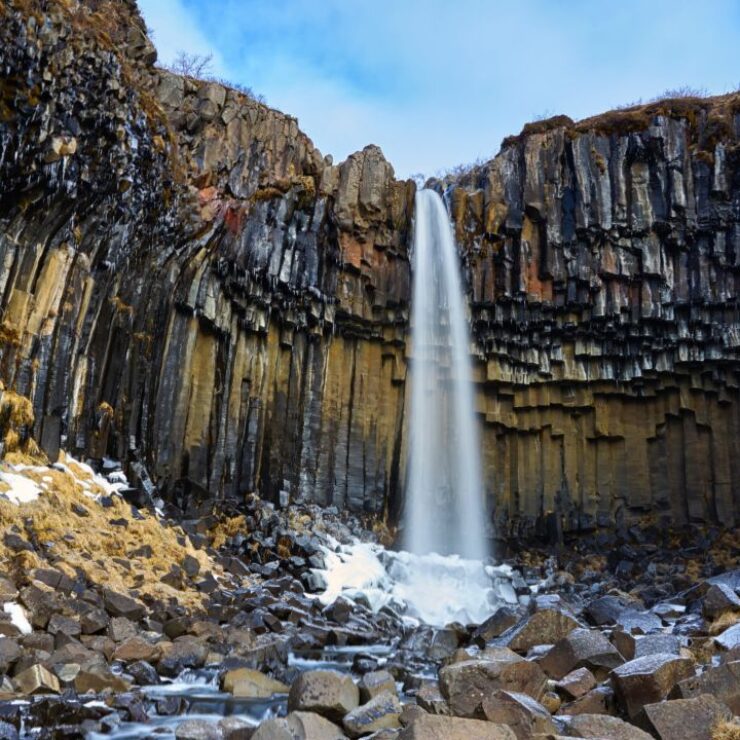La cascata di Gullfoss, nota anche come "Golden Falls", è una meraviglia naturale mozzafiato situata nel sud-ovest dell'Islanda. Con la sua maestosa cascata a due livelli, Gullfoss è considerata una delle cascate più iconiche e amate del paese. In questa guida completa, esploreremo la storia, la geografia e le caratteristiche uniche di Gullfoss, oltre a fornire informazioni pratiche per visitare questa attrazione mozzafiato.
1. Introduzione alla cascata Gullfoss
Gullfoss, che in islandese significa "Cascate dorate", è un'affascinante cascata situata nel canyon del fiume Hvítá. È una tappa importante lungo il famoso percorso turistico del Golden Circle, che comprende anche l'area geotermica di Geysir e il parco nazionale di Þingvellir. Il nome della cascata deriva dalla tonalità dorata che l'acqua glaciale assume mentre precipita dalle cascate.
Gullfoss è una cascata a più livelli che scende per un totale di 32 metri (105 piedi) in un canyon stretto e spettacolare. Le cascate sono in realtà composte da due salti separati, con il primo che misura 11 metri (36 piedi) e il secondo che misura 21 metri (69 piedi). La potenza e la bellezza assolute di Gullfoss la rendono una destinazione imperdibile per gli amanti della natura e gli amanti dell'avventura che visitano l'Islanda.
2. La formazione e la geografia di Gullfoss
La cascata di Gullfoss si è formata durante l'ultima era glaciale, circa 5.000 anni fa. Le acque del fiume Hvítá, che ha origine dal ghiacciaio Langjökull, si fanno strada attraverso il paesaggio aspro, creando lo straordinario canyon che ospita Gullfoss. Il canyon si estende per oltre 2,5 chilometri (1,6 miglia) e raggiunge profondità fino a 70 metri (230 piedi).
Mentre il fiume Hvítá scorre verso sud, fa una brusca svolta nei pressi di Gullfoss e precipita nel canyon in una serie di cascate. La forza dell'acqua crea un'ipnotizzante dimostrazione di potenza pura, con gli spruzzi delle cascate che spesso formano arcobaleni nelle giornate di sole. L'acqua di disgelo glaciale conferisce a Gullfoss il suo caratteristico colore dorato, aggiungendone fascino.
3. La leggenda di Sigríður Tómasdóttir e la conservazione di Gullfoss
Gullfoss occupa un posto significativo nella storia islandese, grazie agli sforzi di Sigríður Tómasdóttir. All'inizio del XX secolo, gli investitori stranieri cercarono di sfruttare il potenziale della cascata per la produzione di energia idroelettrica. Sigríður, la figlia del contadino che possedeva la terra circostante Gullfoss, si oppose con veemenza a questi piani e lottò instancabilmente per proteggere la cascata.
La leggenda narra che Sigríður minacciò addirittura di gettarsi nella cascata se la costruzione di una centrale elettrica fosse andata avanti. La sua determinazione e il suo incrollabile impegno nel preservare Gullfoss alla fine portarono alla cancellazione del contratto di locazione con gli investitori stranieri. Nel 1940, il figlio adottivo di Sigríður acquistò la cascata e in seguito la vendette al governo islandese, assicurandone la conservazione a lungo termine.
Oggi, una pietra commemorativa dedicata a Sigríður Tómasdóttir si trova vicino a Gullfoss, a commemorazione dei suoi coraggiosi sforzi per salvaguardare questo tesoro naturale. La sua eredità come prima ambientalista islandese vive ancora e i visitatori possono renderle omaggio apprezzando e rispettando la bellezza di Gullfoss.
"Non venderò il mio amico!" – Tómas Tómasson, proprietario di Gullfoss, in risposta all'offerta di un uomo d'affari inglese di acquistare la cascata.
4. Gullfoss nelle diverse stagioni: uno spettacolo visivo
Gullfoss offre un'esperienza unica e accattivante durante tutto l'anno, con ogni stagione che mostra il suo fascino distinto. Nei mesi estivi, l'acqua di disgelo glaciale del ghiacciaio Langjökull gonfia il fiume Hvítá, dando origine a un potente torrente d'acqua che si riversa sulle cascate. Gli spruzzi delle cascate creano una nebbia ipnotizzante che spesso forma arcobaleni, aggiungendo un tocco etereo al paesaggio.
Durante l'inverno, Gullfoss subisce una sorprendente trasformazione, poiché le temperature gelide trasformano la cascata in un paese delle meraviglie ghiacciato. L'acqua che scorre sulle cascate si ghiaccia gradualmente, formando intricate formazioni di ghiaccio e ghiaccioli che luccicano alla luce del sole. Il paesaggio ghiacciato che circonda Gullfoss aggiunge alla bellezza drammatica della cascata, rendendola una destinazione popolare per gli avventurieri invernali e i fotografi.
Non importa la stagione, Gullfoss non manca mai di stupire con le sue dimensioni, la sua potenza e la sua bellezza naturale. Che tu assista alla cascata nel suo splendore estivo o che ti meravigli della sua magnificenza ghiacciata in inverno, Gullfoss promette un'esperienza indimenticabile.
5. Arrivare a Gullfoss: accesso e opzioni di trasporto
Gullfoss è situato in una posizione comoda e facilmente raggiungibile da Reykjavik, il che lo rende una popolare meta per gite di un giorno sia per la gente del posto che per i turisti. La cascata si trova sul percorso del Golden Circle, un noto circuito turistico che comprende diverse delle attrazioni naturali più straordinarie dell'Islanda.
5.1 Guidare verso Gullfoss
Guidare fino a Gullfoss è un'opzione semplice e il percorso da Reykjavik è ben segnalato. Dalla capitale, dirigiti verso est sulla Ring Road (Route 1) e segui le indicazioni per il Golden Circle. Dopo circa 54 chilometri (34 miglia), svolta a destra sulla Route 35, che conduce direttamente a Gullfoss. Il viaggio da Reykjavik a Gullfoss dura circa 1 ora e 30 minuti.
La strada che porta a Gullfoss è ben tenuta, soprattutto considerando la sua posizione artica. I visitatori possono aspettarsi strade lisce e senza buche, rendendo la guida autonoma un'opzione accessibile e piacevole. Tuttavia, è essenziale prestare attenzione e guidare con prudenza, soprattutto durante l'inverno, quando le condizioni meteorologiche possono essere difficili. Controlla sempre le previsioni del tempo e le condizioni stradali prima di intraprendere il tuo viaggio.
5.2 Visite guidate a Gullfoss
Per coloro che preferiscono non guidare o desiderano un'esperienza più immersiva, sono ampiamente disponibili tour guidati a Gullfoss. Vari tour operator offrono tour del Golden Circle che includono fermate a Gullfoss, insieme ad altre attrazioni popolari come l'area geotermica di Geysir e il Parco nazionale di Þingvellir. Questi tour forniscono commenti informativi da guide esperte e ti consentono di sederti, rilassarti e goderti il panorama.
Inoltre, ci sono pacchetti turistici specificamente pensati per gli amanti dell'avventura, come tour in motoslitta o escursioni che combinano Gullfoss con attività emozionanti nella zona circostante. Questi tour offrono una prospettiva unica di Gullfoss e ti permettono di esplorare le meraviglie naturali dell'Islanda in un modo più immersivo.
6. Esplorare i dintorni: altre attrazioni vicino a Gullfoss
Gullfoss non è l'unica attrazione mozzafiato nei dintorni. Il percorso del Golden Circle offre una ricchezza di meraviglie naturali e punti di riferimento culturali che vale la pena esplorare durante la tua visita a Gullfoss. Ecco alcune attrazioni degne di nota nei pressi di Gullfoss:
6.1 Area geotermica di Geysir
L'area geotermica di Geysir, situata a circa 10 chilometri (6 miglia) da Gullfoss, ospita il famoso geyser Strokkur. Strokkur erutta ogni pochi minuti, sparando acqua bollente in aria, offrendo uno spettacolo emozionante per i visitatori. L'area geotermica presenta anche pozze di fango gorgoglianti e altri fenomeni geotermici, offrendo uno scorcio unico del paesaggio vulcanico islandese.
6.2 Parco nazionale di Þingvellir
Il Parco nazionale di Þingvellir, patrimonio mondiale dell'UNESCO, è una tappa essenziale sulla rotta del Circolo d'Oro. Il parco ha una notevole importanza storica e culturale, in quanto è stato il sito del primo parlamento islandese, fondato nel 930 d.C. Oltre al suo significato storico, Þingvellir è rinomato per la sua straordinaria bellezza naturale, tra cui la fessura di Silfra, dove i visitatori possono fare snorkeling o immersioni tra le placche tettoniche del Nord America e dell'Eurasia.
6.3 Cascata Faxi
Situata a breve distanza da Gullfoss, la cascata Faxi è un altro gioiello nascosto che vale la pena visitare. Sebbene più piccola in scala rispetto a Gullfoss, Faxi offre un ambiente tranquillo e pittoresco. I visitatori possono ammirare la cascata da vari punti panoramici e godersi i dintorni tranquilli.
Questi sono solo alcuni esempi delle attrazioni vicino a Gullfoss che puoi esplorare durante la tua visita. Ognuno di questi siti offre un'esperienza unica e contribuisce alla bellezza e alla ricchezza complessiva del percorso del Golden Circle.
7. Attività e avventure a Gullfoss
Gullfoss non solo affascina i visitatori con la sua bellezza naturale, ma offre anche una serie di attività e avventure per coloro che cercano un'esperienza più immersiva. Ecco alcune opzioni entusiasmanti da considerare quando si visita Gullfoss:
7.1 Rafting sul fiume Hvítá
Il fiume Hvítá, che scorre attraverso Gullfoss, offre un'entusiasmante opportunità per il rafting. Gli spiriti avventurosi possono imbarcarsi in un emozionante viaggio di rafting lungo le rapide del fiume, sperimentando in prima persona la potenza delle acque glaciali. Sono disponibili tour guidati, adatti a diversi livelli di abilità, rendendolo un'attività adrenalinica sia per i principianti che per i rafter esperti.
7.2 Motoslitta sul ghiacciaio Langjökull
Per un'esperienza davvero indimenticabile, prendi in considerazione l'idea di imbarcarti in un'avventura in motoslitta sul vicino ghiacciaio Langjökull. I tour guidati ti consentono di esplorare la vasta distesa ghiacciata, cavalcando sulla superficie incontaminata del ghiacciaio e ammirando le viste panoramiche mozzafiato. Questa attività emozionante unisce la bellezza del paesaggio islandese a un'avventura ricca di adrenalina.
7.3 Escursioni e passeggiate nella natura
Gullfoss e i suoi dintorni offrono eccellenti opportunità per escursioni e passeggiate nella natura. Ci sono diversi sentieri segnalati che ti permettono di esplorare gli splendidi paesaggi al tuo ritmo. Che tu preferisca brevi passeggiate verso punti panoramici o escursioni più lunghe attraverso il terreno accidentato, c'è qualcosa per tutti i gusti.
Questi sono solo alcuni esempi delle attività e delle avventure che ti aspettano a Gullfoss. Che tu scelga di provare l'emozione del rafting, l'euforia della motoslitta o la tranquillità di una passeggiata nella natura, Gullfoss promette di essere una destinazione che soddisfa il tuo senso di avventura.
8. Consigli di sicurezza e turismo responsabile a Gullfoss
Sebbene Gullfoss sia un'attrazione naturale affascinante, è fondamentale dare priorità alla sicurezza e praticare un turismo responsabile durante la visita. Ecco alcuni importanti consigli di sicurezza da tenere a mente:
- Rimani sui sentieri e sui percorsi segnalati: rispetta l'ambiente naturale e resta sui sentieri segnalati quando esplori Gullfoss e i suoi dintorni. Allontanarsi dai sentieri segnalati può causare danni irreversibili al delicato ecosistema.
- Segui tutti i segnali di sicurezza e le avvertenze: presta attenzione a tutti i segnali di sicurezza o alle avvertenze affissi nell'area. Questi segnali sono stati posizionati per garantire la tua sicurezza e proteggere la bellezza naturale di Gullfoss.
- Siate consapevoli delle mutevoli condizioni meteo: il meteo in Islanda può essere imprevedibile, quindi è essenziale controllare le previsioni prima della vostra visita ed essere preparati a condizioni mutevoli. Vestitevi a strati, indossate calzature robuste e portate l'attrezzatura adatta alla stagione.
- Pratica una gestione responsabile dei rifiuti: aiuta a mantenere incontaminati Gullfoss e i suoi dintorni smaltisci correttamente i rifiuti. Utilizza i bidoni e le strutture di riciclaggio designati ed evita di lasciare rifiuti.
- Rispetta la fauna selvatica e la vegetazione: sii consapevole del fragile ecosistema di Gullfoss e astieniti dal disturbare o nutrire la fauna selvatica. Evita di calpestare la vegetazione e lascia la natura come l'hai trovata.
Seguendo questi consigli di sicurezza e praticando un turismo responsabile, potrai vivere un'esperienza sicura e piacevole a Gullfoss, preservandone al contempo la bellezza naturale per le generazioni future.
9. Il momento migliore per visitare Gullfoss: consigli e raccomandazioni
Gullfoss è una destinazione per tutto l'anno, ogni stagione offre il suo fascino unico. Ecco alcuni suggerimenti per aiutarti a pianificare la tua visita a Gullfoss:
9.1 Estate (da giugno ad agosto)
Durante i mesi estivi, Gullfoss è al suo massimo splendore, con l'acqua di disgelo dei ghiacciai che scorre a tutta forza. Le lunghe ore di luce offrono ampio tempo per esplorare la zona e scattare fotografie spettacolari. Tuttavia, l'estate è anche l'alta stagione turistica, quindi aspettati una folla più numerosa. Per evitare i periodi di maggiore affluenza, considera di visitare la mattina presto o la sera tardi.
9.2 Inverno (da dicembre a febbraio)
L'inverno trasforma Gullfoss in un magico paese delle meraviglie, con le temperature gelide che creano formazioni di ghiaccio che luccicano alla luce del sole. Visitare Gullfoss in inverno offre un'esperienza più tranquilla e serena, con meno turisti. Tuttavia, tieni presente che le condizioni meteorologiche possono essere rigide e l'accesso a determinati punti panoramici potrebbe essere limitato a causa di ghiaccio e neve. Vestiti pesantemente e preparati alle superfici ghiacciate.
9.3 Stagioni intermedie (primavera e autunno)
La primavera (da marzo a maggio) e l'autunno (da settembre a novembre) offrono un equilibrio tra la stagione estiva e quella invernale. I paesaggi sono spesso adornati da colori vivaci e il clima è più mite rispetto agli estremi dell'estate e dell'inverno. Queste stagioni offrono un'atmosfera più tranquilla e sono ideali per chi cerca un'esperienza più tranquilla.
Non importa il periodo dell'anno, Gullfoss promette un'esperienza accattivante. Considera le tue preferenze per i livelli di folla, le condizioni meteorologiche e le caratteristiche uniche di ogni stagione quando pianifichi la tua visita.
10. Alloggi e ristoranti nelle vicinanze
Sebbene Gullfoss in sé non disponga di sistemazioni o strutture per la ristorazione in loco, ci sono diverse opzioni disponibili nella zona circostante per migliorare la vostra visita. Ecco alcuni consigli:
10.1 Sistemazioni
- Hotel Gullfoss: Situato a breve distanza dalla cascata, l'Hotel Gullfoss offre camere confortevoli e viste mozzafiato sui paesaggi circostanti.
- Geysir Cottages: Situati nei pressi dell'area geotermica di Geysir, i Geysir Cottages offrono sistemazioni accoglienti e ben attrezzate in un ambiente pittoresco.
- Alloggi con angolo cottura: se preferisci un'esperienza più indipendente, potresti prenotare un cottage o un appartamento con angolo cottura nelle vicine città di Reykholt o Laugarvatn.
10.2 Opzioni di ristorazione
- Gullfoss Café: adiacente alla cascata Gullfoss, il Gullfoss Café offre una varietà di bevande, tra cui zuppe calde, panini, insalate e dolci tradizionali islandesi.
- Fridheimar: situato vicino alla zona di Geysir, Fridheimar è un'esperienza culinaria unica dove puoi gustare un pasto circondato da piante di pomodoro in una serra. Il loro menu offre deliziosi piatti preparati con pomodori coltivati localmente.
Queste sono solo alcune delle opzioni per alloggi e ristoranti vicino a Gullfoss. Si consiglia di prenotare in anticipo, soprattutto durante l'alta stagione turistica.
11. Suggerimenti fotografici per catturare la bellezza di Gullfoss
Gullfoss offre uno sfondo mozzafiato per gli amanti della fotografia. Ecco alcuni suggerimenti per aiutarti a catturare la bellezza di questa magnifica cascata:
- Visita durante l'ora d'oro: la luce morbida e calda durante l'ora dopo l'alba e prima del tramonto può esaltare i colori e le texture di Gullfoss. Pianifica la tua visita di conseguenza per sfruttare al meglio questo momento magico.
- Sperimenta diverse angolazioni: Gullfoss offre una gamma di punti di vista, quindi non aver paura di esplorare diverse angolazioni e composizioni. Considera di catturare la cascata dall'alto, dal basso o da varie prospettive lungo il sentiero.
- Usa un filtro polarizzante: un filtro polarizzante può aiutare a ridurre l'abbagliamento e a migliorare i colori del paesaggio. Può anche aiutare a catturare gli arcobaleni che spesso si formano nella nebbia di Gullfoss.
- Includi elementi in primo piano: incorpora elementi in primo piano, come rocce o vegetazione, per aggiungere profondità e interesse alle tue fotografie.
- Tecniche di esposizione lunga: sperimenta con la fotografia a lunga esposizione per creare un effetto fluido ed etereo sull'acqua che cade a cascata. Utilizza un treppiede per garantire stabilità e regola di conseguenza la velocità dell'otturatore.
Ricordatevi di rispettare l'ambiente e gli altri visitatori mentre scattate le vostre fotografie. Siate consapevoli dell'ambiente circostante e seguite le linee guida o le restrizioni in vigore.
12. Conclusione: Gullfoss, una meraviglia imperdibile dell'Islanda
La cascata di Gullfoss è una testimonianza della potenza e della bellezza della natura. Con la sua affascinante cascata a due livelli, la sua ricca storia e i suoi dintorni mozzafiato, Gullfoss è una destinazione imperdibile per chiunque visiti l'Islanda. Che tu veda la cascata nel suo splendore estivo o che ti meravigli della sua magnificenza ghiacciata in inverno, Gullfoss promette un'esperienza mozzafiato che lascerà un'impressione duratura.
Dagli sforzi di conservazione di Sigríður Tómasdóttir alle attività e alle avventure disponibili nella zona, Gullfoss offre una gamma di esperienze per ogni viaggiatore. Esplora le attrazioni circostanti, intraprendi avventure emozionanti e immergiti nei paesaggi mozzafiato dell'Islanda sud-occidentale.
Quando visiti Gullfoss, ricorda di dare priorità alla sicurezza, di praticare un turismo responsabile e di rispettare la bellezza naturale di questa cascata iconica. Cattura la sua bellezza attraverso la fotografia, ma prenditi anche un momento per rimanere semplicemente in soggezione di fronte alla maestosità e alla potenza di Gullfoss.
Organizza oggi stesso la tua visita alla cascata Gullfoss e intraprendi un viaggio indimenticabile nel cuore delle meraviglie naturali dell'Islanda.






